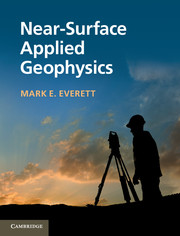Book contents
- Frontmatter
- Contents
- Preface
- Acknowledgments
- 1 Introduction
- 2 Data analysis
- 3 Magnetics
- 4 Electrical resistivity method
- 5 Induced polarization and self-potential
- 6 Seismic reflection and refraction
- 7 Seismic surface-wave analysis
- 8 Electromagnetic induction
- 9 Ground-penetrating radar
- 10 Emerging techniques
- 11 Linear inversion
- 12 Non-linear inversion: local methods
- 13 Non-linear inversion: global methods
- Appendix A Shannon sampling theorem
- Appendix B Solution of Laplace’s equation in spherical coordinates
- Appendix C The linear τ–p transformation of seismic data
- Appendix D Horizontal loop over a conducting halfspace
- Appendix E Radar TE waveguide mode equations
- References
- Index
- Plate section
6 - Seismic reflection and refraction
Published online by Cambridge University Press: 05 April 2013
- Frontmatter
- Contents
- Preface
- Acknowledgments
- 1 Introduction
- 2 Data analysis
- 3 Magnetics
- 4 Electrical resistivity method
- 5 Induced polarization and self-potential
- 6 Seismic reflection and refraction
- 7 Seismic surface-wave analysis
- 8 Electromagnetic induction
- 9 Ground-penetrating radar
- 10 Emerging techniques
- 11 Linear inversion
- 12 Non-linear inversion: local methods
- 13 Non-linear inversion: global methods
- Appendix A Shannon sampling theorem
- Appendix B Solution of Laplace’s equation in spherical coordinates
- Appendix C The linear τ–p transformation of seismic data
- Appendix D Horizontal loop over a conducting halfspace
- Appendix E Radar TE waveguide mode equations
- References
- Index
- Plate section
Summary
The seismic-reflection and -refraction methods in near-surface geophysical investigations are based on the introduction of mechanical energy into the subsurface using an active source and the recording, typically using surface geophones, of the resulting mechanical response. Passive-source seismic methods also provide important information; these will be described in Chapter 7. The propagation of mechanical energy into the subsurface consists, to a large part, of elastic waves. The essential property of an elastic body is that it returns instantaneously to its original pre-deformed state with the removal of a mechanical force that changed its size and/or shape. A delayed return to the original state is termed viscoelasticity. Any permanent deformation, such as ductile deformation or brittle failure, is a measure of the inelasticity of the body. Significant permanent deformation of the ground surface can occur in the vicinity of large seismic disturbances such as earthquakes (e.g. Lee and Shih, 2011) but inelasticity can be safely neglected in most near-surface active-source or passive-source studies. An important characteristic of elasticity is the relationship between the strain, or deformation, of a body and the stress, or mechanical force, that produces the deformation of the body. An excellent review of the elementary physics of wave motion is found in French (1971).
Introduction
There are several possible types of elastic wave motion following the introduction of a seismic disturbance. The particle motion associated with compressional, or P-waves, is aligned with the direction of wave propagation (Figure 6.1a). The particle motion associated with shear, or S-waves, is aligned in a direction perpendicular to the direction of wave propagation (Figure 6.1b). Both vertically polarized (SV, as shown in the figure) and horizontally polarized (SH) motions are possible. The P- and S-waves are known as body waves since they are transmitted through the interior of the Earth. As shown by the shaded cells in the figure, P-waves are associated with a change in size and aspect ratio of an elementary material volume while S-waves are associated with a change in shape. With surface Rayleigh, or R-waves, discussed more fully in the next chapter, the particle motion near the surface is retrograde elliptical (Figure 6.1c, top) and only those particles in the region close to the surface of the Earth, at depths comparable to the elastic wavelength, are set into motion. A second type of surface wave motion (Figure 6.1c, bottom) is characterized by horizontal particle motion that oscillates transverse to the direction of wave propagation. Such waves are termed Love waves.
- Type
- Chapter
- Information
- Near-Surface Applied Geophysics , pp. 125 - 181Publisher: Cambridge University PressPrint publication year: 2013

